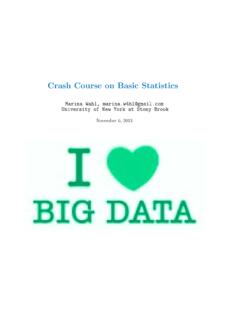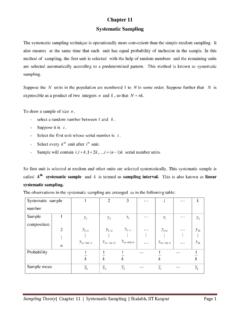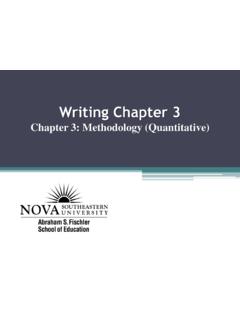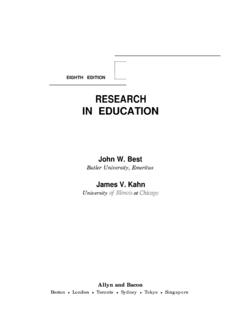Transcription of CHAPTER 9 Audit Sampling - files.sba.wayne.edu
1 CHAPTER 09 - Audit Sampling CHAPTER 9. Audit Sampling Review Questions 9 1 Nonstatistical Sampling is an Audit Sampling technique in which the risk of Sampling error is estimated by the auditors using professional judgment rather than by the laws of probability. Statistical Sampling involves the quantification of the risk of Sampling error through the use of mathematics and laws of probability. 9 2 Sampling risk is the possibility that the auditors will make an erroneous decision based on a sample result. To control Sampling risk the auditors increase the size of their samples. Nonsampling risk is the risk of erroneous conclusions by the auditors based on any factor other then Sampling . For example, the auditors may perform inappropriate tests, or they may not recognize errors in the sample items examined. Nonsampling risk may be controlled by adequate planning and supervision of engagements, and the establishment of effective quality control policies and procedures.
2 9 3 The physical representation of the actual population is the recorded value that represents the population. For example, if the auditors use a computer printout of recorded accounts payable from which to sample, they must attempt to determine that it properly includes all accounts payable. 9 4 All three of the methods of selecting items for examination (random number table selection, systematic selection, random number generator selection) will produce a random sample if properly applied. However, when using systematic Sampling on a population that is not in random order, it may be necessary to stratify the population into segments or to use a relatively large number of starting points to produce a random sample. 9 5 " systematic selection" in auditing means drawing every nth item from the population of items to be sampled.
3 For example, the auditors might draw every tenth check from a file of paid checks. To help insure a random sample, the auditors should ascertain that the population is in random sequence, and is not, for example, classified by size of check. If the population is not in random order, the auditors may be able to stratify it into segments, each of which is in random order. They may also guard against a nonrandom sample by using several random starting points. systematic selection is easily applied to unnumbered documents merely by counting off the Sampling interval between documents to be selected. 9 6 Sampling without replacement means that once an item is drawn for inclusion in a sample, it is not replaced into the population prior to drawing the remaining items. Therefore, one item cannot be included more than once in a given sample.
4 Sampling with replacement means that selected items are replaced into the population prior to drawing the next item. Under this method, it is possible for one item in the population to be drawn several times, thus representing several sample items in a given sample. 9-1. 2014 by McGraw-Hill Education. This is proprietary material solely for authorized instructor use. Not authorized for sale or distribution in any manner. This document may not be copied, scanned, duplicated, forwarded, distributed, or posted on a website, in whole or part. CHAPTER 09 - Audit Sampling 9 7 Sampling without replacement results in a smaller sample because the population is treated as finite. 9 8 If a particular account is drawn twice when Sampling with replacement, the item is included twice in the sample. Note that when Sampling without replacement the item is only included once.
5 9 9 The three major factors that determine the sample size for an attributes Sampling plan are (1) the risks of assessing control risk too low, (2) the tolerable deviation rate, and (3) the expected population deviation rate. In addition, the size of the population has a small effect on the sample size. 9 10 In estimating the expected population deviation rate the auditors often use (1) the sample results from prior years, (2) experience with similar tests for other clients, or (3) results of a small pilot sample. 9 11 Combining several types of attributes in a definition of a deviation is acceptable, provided that the attributes are of similar Audit significance. Note, however, that if various attributes of differing importance are combined, the significance of a specified deviation rate becomes obscured. 9 12 When an auditor believes that the expected rate exceeds the tolerable deviation rate, no test of controls will generally be performed.
6 This is because control risk will normally be assessed at the maximum level since the control is believed to be ineffective since the expected deviation rate exceeds the deviation rate exceeding the tolerable deviation rate. 9 13 A dual-purpose test is one which tests and internal control procedure and substantiates the dollar amount of an account balance. 9 14 When performing dual-purpose test the sample size is determined by calculating the sample sizes for each of the purposes and then using the larger of the two. 9 15 Yes. If the sample was drawn on a random basis, the sample results should represent the true population characteristic within a specified allowance for Sampling risk and with a specified level of Sampling risk. 9 16 Expected deviation rate is a term associated with attributes Sampling . In Sampling for attributes, the required sample size will vary directly with the expected deviation rate.
7 The higher the expected deviation rate, the larger the sample required to give an estimate of the true deviation rate with a specified Sampling risk and allowance for Sampling risk. Some students may point out that the higher the "true" deviation rate the smaller the sample size needed in discovery Sampling . While this observation is correct, the "expected" deviation rate in a discovery Sampling plan is always zero. 9 17 Attributes Sampling would estimate the percentage of extensions that are in error, and variables Sampling would estimate total dollar amount of misstatements in the schedule. In general, attributes Sampling estimates the deviation rate (occurrence rate) of a characteristic, and the variables Sampling estimates the dollar value of a characteristic. 9 18 In using a sequential Sampling plan, the auditors select a small initial sample, and based on the results of examining it they decide (1) to assess control risk at the planned level, (2) assess control risk at a level higher than the planned level, or (3) to increase their sample size to get more information about operating effectiveness of the procedure.
8 If they decide to increase their sample 9-2. 2014 by McGraw-Hill Education. This is proprietary material solely for authorized instructor use. Not authorized for sale or distribution in any manner. This document may not be copied, scanned, duplicated, forwarded, distributed, or posted on a website, in whole or part. CHAPTER 09 - Audit Sampling size, they make a similar decision after examining the additional items. The process usually continues for no more than four stages. 9 19 In performing substantive tests of the book value of a population, the two aspects of Sampling risk are: a. The risk of incorrect rejection that is, the possibility that the sample will indicate the existence of material misstatement when, in fact, material misstatement does not exist. b. The risk of incorrect acceptance that is, the possibility that the sample results will cause the auditor to accept the population as free of material misstatement when, in fact, material misstatement does exist.
9 The risk of incorrect acceptance is of more significance to auditors than the risk of incorrect rejection. If auditors incorrectly reject a population, they will perform more Audit procedures to determine the nature and extent of the assumed material misstatement. These additional procedures will, presumably, lead the auditors to the correct conclusion. Thus, the risk of incorrect rejection causes inefficiency in the Audit process, but does not cause the auditors to overlook material misstatements in the financial statements. The risk of incorrect acceptance, on the other hand, can lead directly to material misstatement being present in the audited statements. The condition can result in losses to those relying upon the financial statements, and possible legal liability for the auditors. 9 20 The auditors may obtain an estimate of the dollar amount of the standard deviation by procedures such as by (1) using the results obtained in previous years, (2) calculating the standard deviation of the population's book values, or (3) taking a small pilot sample.
10 9 21 The planned allowance for Sampling risk is first used as an input into the formula for determining the appropriate sample size. It is then used for evaluating sample results when the sample's standard deviation is equal to the estimated standard deviation. Note: In cases in which the estimated standard deviation differs from that obtained in the sample, an adjusted allowance for Sampling risk may be calculated. 9 22 An adjusted allowance for Sampling risk will be calculated when the estimated standard deviation differs from that obtained in the sample. This method keeps the risk of incorrect acceptance at its planned level. Students may point out that it can be calculated in all circumstances for evaluation purposes in that it provides the planned allowance for Sampling risk in situations in which the estimated and sample's (audited value) standard deviations are equal.





